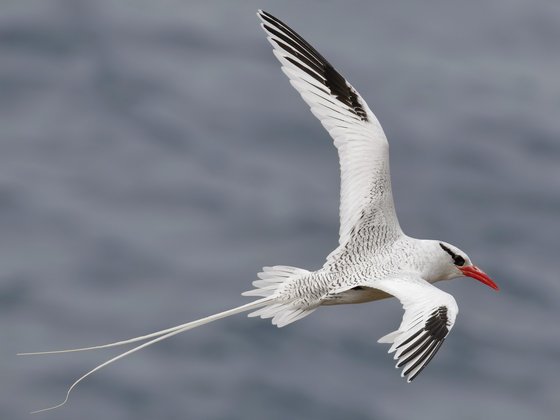To listen to the audio, view the YouTube video above.
These elegant creatures have chosen Saba as one of their key nesting grounds, making it a crucial habitat for their survival. In fact, Saba and Sint Eustatius together support at least 17% of the global population of red-billed tropicbirds, with approximately 1,500 breeding pairs nesting on Saba alone.
A Unique Nesting Ground
Saba is one of the few islands in the Caribbean where these birds come to nest and rear their chicks. Their nesting sites are often located on the cliffs at Tent Bay, hidden in crevices. Unlike other migratory birds that may shift nesting locations, red-billed tropicbirds display remarkable nest fidelity (meaning that red-billed tropicbirds are loyal to their mates and nesting sites), often returning to the same rock cavity year after year, even if previous nesting attempts were unsuccessful due to predators eating eggs or chicks, or if the eggs simply did not hatch.
The Threats to Their Survival
The red-billed tropicbirds’ loyalty also makes them prime targets for continuous attacks by predators. The primary dangers come from feral cats and rats. These predators frequently prey on the birds' single egg or newly hatched chick, significantly impacting their population. Researchers have even noted instances where every chick at Tent Bay disappeared, presumably due to predation by feral cats (Gibbs, 2022). The stark contrast in survival rates is evident when comparing Saba to Sint Eustatius, where the feral cat problem is not as prevalent, resulting in almost 80% of chicks surviving after hatching in 2017-2018.
To increase the survival rate of the tropic bird, it is necessary to evaluate and remove threats to its population.
Ecological and Economic Importance
Beyond their beauty, red-billed tropicbirds play a vital role in maintaining biodiversity. As seabirds, they contribute to nutrient cycling within their ecosystems, supporting marine and terrestrial life. Additionally, they serve as an important attraction for birdwatchers and eco-tourists. Birdwatching is a growing industry, and the opportunity to observe these majestic birds in their natural habitat can enhance Saba’s eco-tourism sector. Protecting these birds not only preserves biodiversity but also supports sustainable tourism, benefiting the local economy.
Conservation: Our Shared Responsibility
Given that Saba is home to such a significant portion of the global red-billed tropicbird population, it is our responsibility to protect them. We must be mindful that these birds have chosen Saba as their home, and it is up to us to ensure their safety. Conservation efforts, such as controlling predator population and raising awareness about the importance of these birds, are crucial for their continued survival.
By protecting the red-billed tropicbird, we help maintain the delicate balance of our ecosystem while preserving the natural beauty that makes Saba such a special place. By taking these measures, we can help to ensure that future generations can continue to witness the grace of these remarkable birds in our skies.
